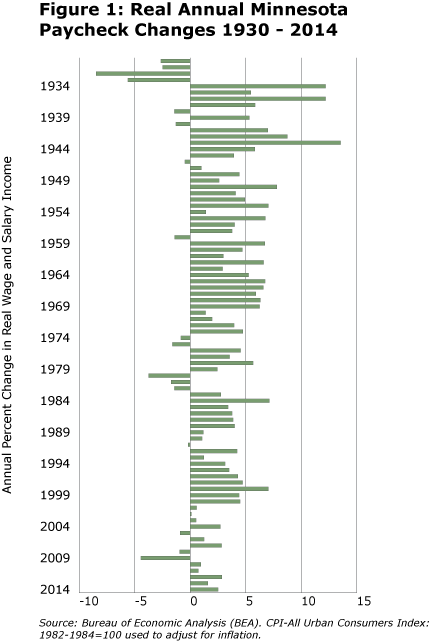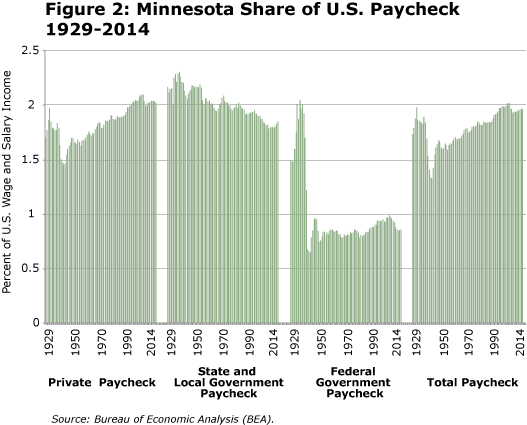
by Dave Senf
September 2015
Total wage and salary income in Minnesota has climbed in 78 of the last 85 years before accounting for inflation, but the rate of growth has slowed in recent years
Minnesota's wage and salary workers cashed in on a record high aggregate paycheck of $145.6 billion last year. That estimate comes from the U.S. Bureau of Economic Analysis (BEA), the same group that produces such closely watched national statistics as the U.S. gross domestic product, personal income and retail sales.1
BEA's wage and salary estimates (or disbursements) are based primarily on quarterly unemployment insurance reports that are filed by employers with state unemployment agencies, including DEED. Minnesota employers report wages and salaries for each employee to DEED's Unemployment Insurance Program. DEED, in turn, aggregates the data and publishes the numbers as part of the Quarterly Census of Employment and Wages (QCEW) program.2
BEA estimates of Minnesota wages and employment are slightly higher than QCEW numbers because the BEA makes several adjustments to QCEW data to account for jobs that are not covered by Minnesota's Unemployment Insurance Program and underreporting of wage income by employers. The most significant adjustment is the addition of uncovered jobs and wages in farm work, private households, private elementary and secondary schools, religious organizations and railroads. BEA wage and salary payments were 3.3 percent higher than the QCEW total in 2014 and have on average exceeded QCEW wage estimates by 3.7 percent since 2000.
BEA wage and salary estimates have two advantages over QCEW numbers. The first is wage data are easily downloaded and cover all states, counties and metro areas in the U.S., making geographical comparisons relatively easy.
The other advantage is that the BEA wage and employment data are available back to 1929, albeit at only one- or two-digit levels of industry detail. QCEW wage and salary payments are much more detailed, covering from one- to six-digit industry levels (when not suppressed in order to protect the confidentiality of company-specific information). Wage and salary data from both sources are used here to track historical and recent changes in Minnesotans' paychecks.
Total wage and salary income reached a record high in Minnesota last year, increasing 4.2 percent from 2013. While wage growth is always a welcome development, last year's jump isn't all that remarkable as Minnesota's aggregated paycheck has increased in 78 out of the last 85 years before accounting for inflation. In most years total nominal wage income climbs in Minnesota from employment gains. But more significant are pay raises and higher bonuses. The pay raises of the 2.7 million Minnesotans holding jobs last year were a lot more crucial to total wage and salary income growth than the wages earned from the 40,000 new jobs added.
Minnesota's aggregate nominal paycheck has climbed for five consecutive years since dropping 4.8 percent in 2009. That decline was the first since 1940 and was another harsh reminder of how hard the Great Recession hit the state. Wage income fell in 2009 as layoffs mounted, pay raises were slashed or skipped, bonuses and stock options evaporated, and the number of hours worked tailed off.
Comparison of wage income data over time isn't particularly useful until the data are adjusted for inflation, as in Figure 1, which shows annual real wage and salary payment changes in Minnesota since 1930. Minnesotans' paychecks rose by an average of 6.3 percent annually over the last 85 years before adjusting for inflation, but only 3 percent after adjusting for inflation.

Minnesota’s wage and salary payments in real terms have declined in 17 years since 1930, or in one out of every five years. Almost all of the shrinking wage income years were recession years, including during the Great Depression, when paychecks declined in six years. The Great Recession reduced real wage income in both 2008 and 2009, one year less than during the early 1980s double-dip recessions. Table 1 displays wage and salary income average annual changes for the past eight decades and the first half of the 2010s decade (2010 to 2014).
| Average Annual Change in Minnesota's Real Paycheck | |
|---|---|
| - | Annual Average Change |
| 1930s | 2.0 |
| 1940s | 4.5 |
| 1950s | 4.5 |
| 1960s | 5.4 |
| 1970s | 2.6 |
| 1980s | 1.9 |
| 1999s | 3.4 |
| 2000s | 0.6 |
| 2010-14 | 1.7 |
| Source: Bureau of Economic Analysis (BEA). CPI - All Urban Consumers Index: 1982-1984=100 used to adjust for inflation. | |
Minnesota's wage and salary income rebound since 2009 has been sub-par compared with all other periods, except when compared with the previous 10 years. Real paychecks increased 1.7 percent annually between 2010 and 2014, which is almost three times faster than the 0.6 percent paycheck growth experienced between 2000 and 2009.
The 2001 recession combined with the Great Recession kept Minnesotans' pay in check in real terms for most of the 2000s. The job rebound since 2009 has been moderate, while wage growth has been lackluster over the last five years, leading to annual average wage and salary growth below the historical annual 3 percent growth.
Minnesota paychecks rose 2.5 percent last year, however, as the labor market tightened. Real wage growth may approach closer to the historical average over the next few years if the labor market continues to tighten and labor shortages become more common, forcing employers to fatten pay raises in order to keep employees and fill openings.
The real paycheck of Minnesotans has rebounded slightly faster than the national paycheck during the last five years, climbing 8.9 percent compared with the 7.8 percent increase nationally. Private sector wage and salary income has grown faster in Minnesota than nationally (11.5 percent versus 11 percent), while state and local government paychecks have decreased less in Minnesota (3 percent versus 5.4 percent).
Historically, state and local government payrolls have rebounded right along with private sector jobs after a recession. This time around, though, state and local government job growth has been slow to rebound in many states, leaving 2014 employment 2.8 percent below the 2009 total nationally. State and local government employment in Minnesota has fared better, but it was only 0.3 percent higher over the same period.
Real federal government paychecks, on the other hand, are down 14 percent in Minnesota over the last five years, compared with a 7.5 percent decline nationally. Declining real federal government wage and salary income following a recession is also unusual.
Minnesota's share of U.S. wage and salary income climbed continuously for almost 50 years starting in the 1950s before reaching a record-high of 2.02 percent in 2002. Private and federal paychecks increased faster in Minnesota than nationally during that span, while state and local government paychecks grew slower than nationally (see Figure 2). The state's share of the total U.S. paycheck slipped slightly from 2004 to 2006 before inching up since the Great Recession.

Minnesota's aggregate paycheck increased by $12.3 billion in inflation-adjusted dollars between 2009 and 2014 using QCEW wage data. That was 3.4 percent higher in real terms than the pre-recession peak in 2007. The U.S. aggregate real paycheck last year was 2.1 percent higher than its 2007 pre-recession peak level.
QCEW wages are gross wages and salaries, including pay for vacation and other paid leave, tips and other gratuities, bonuses and stock options. For most Minnesotans, QCEW earnings are used to pay the rent or mortgage, buy groceries, and finance their shopping mall trips or Internet purchases. Income earned by self-employed workers (or proprietors' income in BEA terminology) is not included in QCEW paycheck numbers.
There are 305 industries in the QCEW data when looked at using the NAICS four-digit industry delineation. Seventy percent of those industries (213) have recorded real wage income growth since 2009 totaling $15.1 billion. The other 30 percent (92) had smaller paychecks in 2014 than in 2009, with a combined $2.8 billion reduction in wage income.
Table 2 lists the industries with the biggest paycheck gains over the last five years, as well as the industries with the biggest paycheck cuts. The top 20 industries accounted for 55 percent of the wage income growth in those industries experiencing wage income gains since 2009. The bottom 20 industries accounted for 75 percent of the wage income lost in those industries with shrinking paychecks.
| Minnesota's Top Industry Real Paycheck Gainers and Losers, 2009 - 2014 (millions of dollars) | ||
|---|---|---|
| NAICS | - | 2009 - 2014 Change |
| 5511 | Management of Companies and Enterprises | 1,741 |
| 5415 | Computer Systems Design and Related Services | 702 |
| 5613 | Employment Services | 634 |
| 5241 | Insurance Carriers | 559 |
| 6221 | General Medical and Surgical Hospitals | 531 |
| 5221 | Depository Credit Intermediation | 507 |
| 4529 | Other General Merchandise Stores | 436 |
| 5239 | Other Financial Investment Activities | 330 |
| 5417 | Scientific Research and Development Services | 315 |
| 5311 | Lessors of Real Estate | 297 |
| 7225 | Restaurants | 293 |
| 5416 | Management, Scientific and Technical Consulting Services | 287 |
| 6211 | Offices of Physicians | 248 |
| 2382 | Building Equipment Contractors | 226 |
| 5419 | Other Professional, Scientific and Technical Services | 224 |
| 4541 | Electronic Shopping and Mail-Order Houses | 221 |
| 4238 | Machinery, Equipment and Supplies Merchant Wholesalers | 218 |
| 4251 | Wholesale Electronic Markets and Agents and Brokers | 207 |
| 2389 | Other Specialty Trade Contractors | 204 |
| 5242 | Agencies, Brokerages and Other Insurance Related Activities | 200 |
| 4812 | Nonscheduled Air Transportation | -38 |
| 5619 | Other Support Services | -39 |
| 8121 | Personal Care Services | -39 |
| 4811 | Scheduled Air Transportation | -39 |
| 5615 | Travel Arrangement and Reservation Services | -42 |
| 3361 | Motor Vehicle Manufacturing | -44 |
| 4245 | Farm Product Raw Material Merchant Wholesalers | -55 |
| 3231 | Printing and Related Support Activities | -69 |
| 6231 | Nursing Care Facilities | -70 |
| Federal Government, Excluding Post Office | -74 | |
| 4241 | Paper and Paper Product Merchant Wholesalers | -89 |
| 5411 | Legal Services | -93 |
| 4451 | Grocery Stores | -94 |
| 3341 | Computer and Peripheral Equipment Manufacturing | -115 |
| 5251 | Insurance and Employee Benefit Funds | -122 |
| State Government, Excluding Colleges and Universities | -126 | |
| 5111 | Newspaper, Periodical, Book, and Directory Publishers | -137 |
| Federal Post Office | -150 | |
| Local Government, Excluding Local Education | -211 | |
| 4521 | Department Stores | -491 |
| Source: Quarterly Census of Wages and Employment (QCEW). CPI - All Urban Consumers Index: 1982-1984=100 used to adjust for inflation. | ||
Industries that led the way in payroll earnings growth tend to be either:
An example of the former type is the computer systems design services industry, which expanded its workforce at three times the rate of overall job expansion and pays its workers more than twice the average wage.
The restaurant industry is an example of the latter industry. Due to the large number of restaurant workers, payroll earnings increased $293 million over the last five years even though job growth was just a tad above average and wages were well below average. Most of the industries with shrinking paychecks in the last few years have continued to cut jobs.
The hefty $1.7 billion jump in management of companies and enterprises paychecks can be traced to above-average pay raises, plus job growth that was 50 percent higher than overall job growth. The industry is made up of employees at corporate headquarters, district and regional offices, and various holding companies.
A large share of the 78,700 Minnesotans employed in this industry last year worked at the corporate offices of one of the state's Fortune 500 companies. The average annual salary in this industry was $115,000 last year, which was the seventh-highest pay across the 305 four-digit industries. Even though the industry accounted for only 3.3 percent of wage and salary jobs in 2014, its employees enjoyed 10.5 percent of the state's increased wage income over the last five years.
That disproportionately large wage income share is part of the Wall Street versus Main Street label attached to the recovery over the last five years. As the state's economy continues to recover from the Great Recession, paychecks in many other industries should begin to catch up with the gains achieved in the management of companies sector.